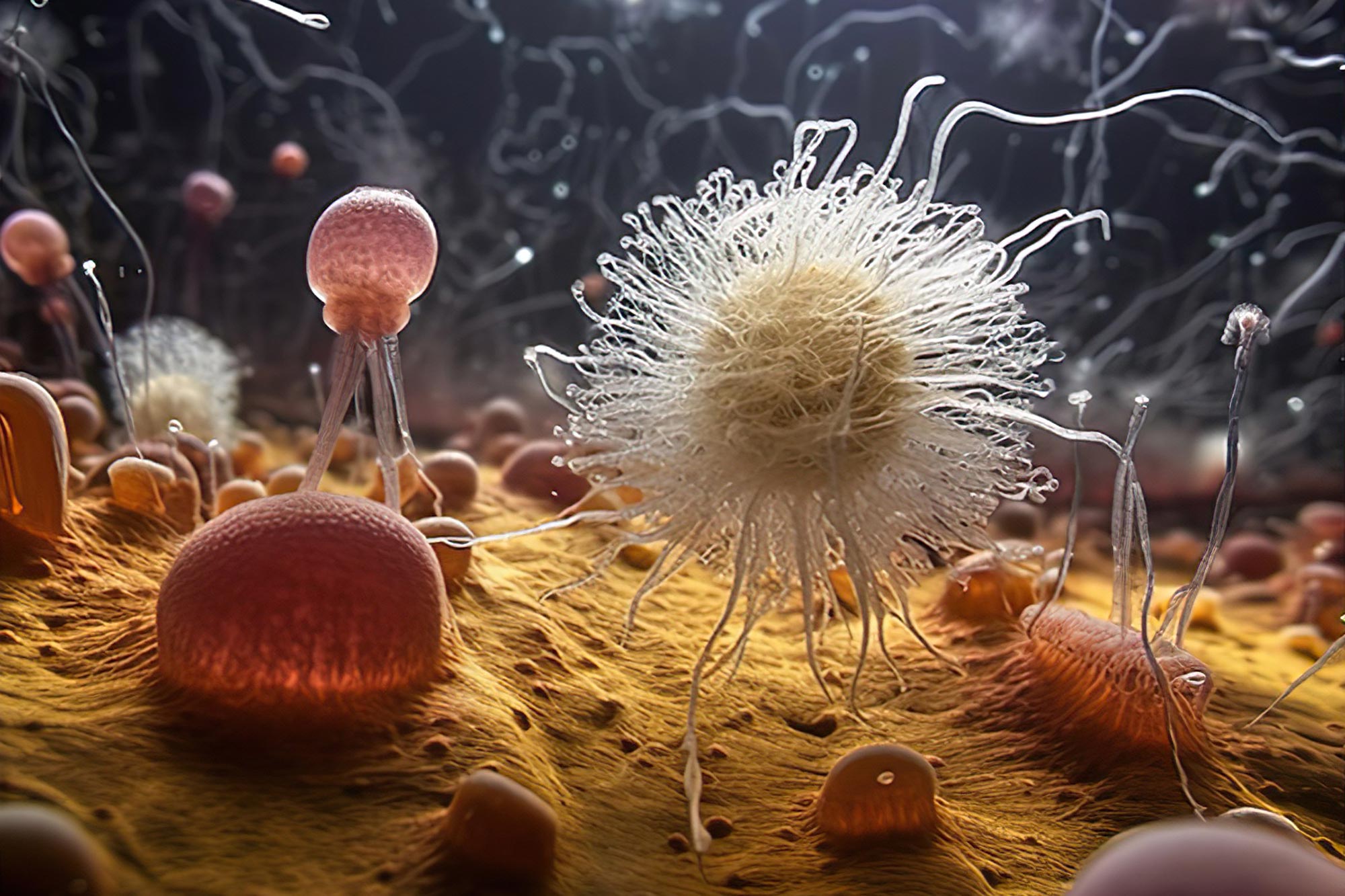oleh
Imajinasi seniman tentang sekelompok eukariota primitif dari “Protosterol Biota” yang hidup di atas tikar bakteri di dasar laut. Berdasarkan fosil molekuler, organisme Protosterol Biota hidup di lautan sekitar 1,6 hingga 1,0 miliar tahun yang lalu dan merupakan nenek moyang tertua kita. Kredit: Diselenggarakan di MidJourney oleh TA 2023
Sebuah tim peneliti multinasional telah menemukan protosteroid kuno di bebatuan, menunjukkan bahwa kehidupan yang kompleks telah ada sejak 1,6 miliar tahun yang lalu. Molekul-molekul ini memberikan wawasan baru ke dalam evolusi kehidupan yang kompleks dan merekonsiliasi perbedaan antara catatan fosil tradisional dan lipid.
Ternyata catatan yang baru ditemukan tentang apa yang disebut protosteroid secara mengejutkan berlimpah sepanjang Abad Pertengahan Bumi. Molekul primordial diproduksi pada tahap awal dalam kompleksitas eukariota – memperpanjang rekor sterol fosil saat ini melampaui 800 dan bahkan 1.600 juta tahun yang lalu. Eukariota adalah istilah yang diberikan kepada kerajaan kehidupan termasuk semua hewan, tumbuhan, dan alga dan dipisahkan dari bakteri dengan memiliki struktur seluler kompleks yang mencakup nukleus, serta mekanisme molekuler yang lebih kompleks.
“Puncak dari penemuan ini bukan sekadar perpanjangan dari catatan molekuler eukariota saat ini,” kata Christian Hollmann, salah satu rekan ilmuwan dari Pusat Penelitian Jerman untuk Geosains (GFZ) di Potsdam. “Mengingat bahwa nenek moyang terakhir dari semua eukariota modern, termasuk kita manusia, kemungkinan besar mampu menghasilkan sterol modern ‘biasa’, kemungkinan eukariota yang bertanggung jawab atas tanda tangan langka ini berada di batang pohon filogenetik.”

Benjamin Nettersheim, salah satu penulis utama studi tersebut, meneliti peta elemen dan molekul resolusi tinggi dari sampel batuan berusia 1,64 miliar tahun yang dianalisis di Laboratorium Pencitraan Molekuler Geobiologis di MARUM. Kredit: MARUM – Pusat Ekologi Kelautan, Universitas Bremen; di Descamps
“Tunggul” ini mewakili garis keturunan leluhur bersama yang merupakan pendahulu dari semua cabang eukariota yang masih hidup. Perwakilannya sudah lama punah, tetapi detail tentang sifat mereka dapat menjelaskan keadaan seputar evolusi kehidupan yang kompleks. Meskipun penelitian lebih lanjut diperlukan untuk menilai persentase protosteroid yang mungkin memiliki sumber bakteri langka, penemuan molekul baru ini tidak hanya merekonsiliasi catatan geologis fosil tradisional dengan molekul lemak fosil, tetapi memberikan pandangan langka dan belum pernah terjadi sebelumnya ke dunia. .hilang dari kehidupan lama. Kematian kompetitif eukariota kelompok batang, yang ditandai dengan kemunculan pertama stroma fosil modern sekitar 800 juta tahun yang lalu, mungkin mencerminkan salah satu peristiwa paling abadi dalam evolusi kehidupan yang semakin kompleks.
tambah Benjamin Nittersheim dari Marom, University of Bremen, yang ikut menulis penelitian ini bersama Jochen Brooks dari[{” attribute=””>Australian National University (ANU) – “due to potentially adverse health effects of elevated cholesterol levels in humans, cholesterol doesn’t have the best reputation from a medical perspective. However, these lipid molecules are integral parts of eukaryotic cell membranes where they aid in a variety of physiological functions. By searching for fossilized steroids in ancient rocks, we can trace the evolution of increasingly complex life.”

Dr. Nettersheim inserts a thin section and rock slices of 1.64 billion-years old rocks into the 7T solariX XR FT-ICR-MS equipped with a MALDI source at the Geobiomolecular Imaging Laboratory at MARUM. As part of ongoing research into mid-Proterozoic biomarker signatures at MARUM, GFZ and the Australian National University, Dr. Nettersheim aims to zoom into the cradle of eukaryotic life in unprecedented resolution. Credit: MARUM – Center for Marine Environmental Sciences, University of Bremen; V. Diekamp
Nobel laureate Konrad Bloch had already speculated about such a biomarker in an essay almost 30 years ago. Bloch suggested that short-lived intermediates in the modern biosynthesis of steroids may not always have been intermediates. He believed that lipid biosynthesis evolved in parallel with changing environmental conditions throughout Earth history. In contrast to Bloch, who did not believe that these ancient intermediates could ever be found, Nettersheim started searching for protosteroids in ancient rocks that were deposited at a time when those intermediates could actually have been the final product.
But how to find such molecules in ancient rocks? “We employed a combination of techniques to first convert various modern steroids to their fossilized equivalent; otherwise, we wouldn’t have even known what to look for,” says Jochen Brocks. Scientists had overlooked these molecules for decades because they do not conform to typical molecular search images. “Once we knew our target, we discovered that dozens of other rocks, taken from billion-year-old waterways across the world, were oozing with similar fossil molecules.”
The oldest samples with the biomarker are from the Barney Creek Formation in Australia and are 1.64 billion years old. The rock record of the next 800 million years only yields fossil molecules of primordial eukaryotes before molecular signatures of modern eukaryotes first appear in the Tonian period. According to Nettersheim “the Tonian Transformation emerges as one of the most profound ecological turning points in our planet´s history“. Hallmann adds that “both primordial stem groups and modern eukaryotic representatives such as red algae may have lived side by side for many hundreds of millions of years”. During this time, however, the Earth’s atmosphere became increasingly enriched with oxygen – a metabolic product of cyanobacteria and of the first eukaryotic algae – that would have been toxic to many other organisms. Later, global “Snowball Earth” glaciations occurred and the protosterol communities largely died out. The last common ancestor of all living eukaryotes may have lived 1.2 to 1.8 billion years ago. Its descendants were likely better able to survive heat and cold as well as UV radiation and displaced their primordial relatives.
“Earth was a microbial world for much of its history and left few traces,” Nettersheim concludes. Research at ANU, MARUM and GFZ continues to pursue tracing the roots of our existence – the discovery of protosterols now brings us one step closer to understanding how our earliest ancestors lived and evolved. Shooting at the ancient rocks with a laser coupled to an ultra-high resolution mass spectrometer in MARUM’s globally unique Geobiomolecular Imaging Laboratory, Dr. Nettersheim and his international collaborators aim at zooming into the cradle of eukaryotic life in unprecedented resolution to further improve our understanding of our early ancestors in the future.
Reference: “Lost world of complex life and the late rise of the eukaryotic crown” by Jochen J. Brocks, Benjamin J. Nettersheim, Pierre Adam, Philippe Schaeffer, Amber J. M. Jarrett, Nur Güneli, Tharika Liyanage, Lennart M. van Maldegem, Christian Hallmann and Janet M. Hope, 7 June 2023, Nature.
DOI: 10.1038/s41586-023-06170-w
Participating Institutions:
- Research School of Earth Sciences, The Australian National University, Canberra, Australia
- MARUM – Center for Marine Environmental Sciences, University of Bremen, Bremen, Germany
- Faculty of Geosciences, University of Bremen, Bremen, Germany
- Université de Strasbourg, CNRS, Institut de Chimie de Strasbourg, Strasbourg, France
- Northern Territory Geological Survey, Darwin, Australia
- German Research Center for Geosciences (GFZ), Potsdam, Germany
MARUM produces fundamental scientific knowledge about the role of the ocean and the ocean floor in the total Earth system. The dynamics of the ocean and the ocean floor significantly impact the entire Earth system through the interaction of geological, physical, biological and chemical processes. These influence both the climate and the global carbon cycle, and create unique biological systems. MARUM is committed to fundamental and unbiased research in the interests of society and the marine environment, and in accordance with the Sustainable Development Goals of the United Nations. It publishes its quality-assured scientific data and makes it publicly available. MARUM informs the public about new discoveries in the marine environment and provides practical knowledge through its dialogue with society. MARUM cooperates with commercial and industrial partners in accordance with its goal of protecting the marine environment.

“Penggemar bir. Sarjana budaya pop yang setia. Ninja kopi. Penggemar zombie jahat. Penyelenggara.”






More Stories
Falcon 9 meluncurkan satelit navigasi Galileo
Mars Express menemukan laba-laba Mars yang misterius
Para ilmuwan menemukan “kejutan” yang mengubah pemahaman mereka tentang alam semesta